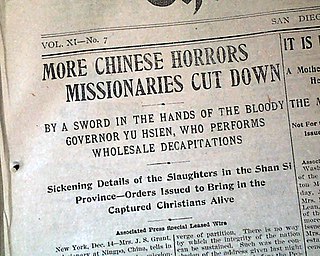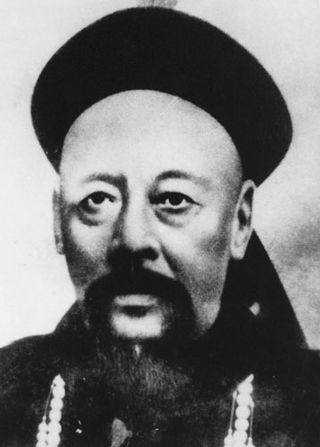
The Boxer Rebellion, also known as the Boxer Uprising or Boxer Insurrection, was an anti-foreign, anti-imperialist, and anti-Christian uprising in North China between 1899 and 1901, towards the end of the Qing dynasty, by the Society of Righteous and Harmonious Fists, known as the "Boxers" in English due to many of its members having practised Chinese martial arts, which at the time were referred to as "Chinese boxing". It was defeated by the Eight-Nation Alliance of foreign powers.
OMF International is an international and interdenominational Evangelical Christian missionary society with an international centre in Singapore. It was founded in Britain by Hudson Taylor on 25 June 1865.
The Tianjin Massacre, also spelled the Tientsin Massacre, was an attack on Christian missionaries and converts in the late 19th century during the late Qing dynasty. 60 people died in attacks on French Catholic priests and nuns. There was intense belligerence from French diplomats, and armed foreign intervention in Tianjin (Tientsin) in 1870. The incident nearly precipitated a war and marked an end to relative cooperation between foreign powers and the Tongzhi court, and adversely affected the ongoing renegotiation of the Treaties of Tientsin, first signed in 1858. French Catholic missionaries were active in China; they were funded by appeals in French churches. The Holy Childhood Association was a Catholic charity founded in 1843 to rescue Chinese children from infanticide. It was a target of Chinese anti-Christian protests led by the local gentry who saw the need to defend Confucianism. Rioting sparked by false rumors of the killing of babies led to the death of a French consul and provoked a diplomatic crisis.

In the early 19th century, Western colonial expansion occurred at the same time as an evangelical revival – the Second Great Awakening – throughout the English-speaking world, leading to more overseas missionary activity. The nineteenth century became known as the Great Century of modern religious missions.

Timothy Richard was a Welsh Baptist missionary to China, who influenced the modernisation of China and the rise of the Chinese Republic.

The Martyr Saints of China, or Augustine Zhao Rong and his Companions, are 120 saints of the Catholic Church. The 87 Chinese Catholics and 33 Western missionaries from the mid-17th century to 1930 were martyred because of their ministry and, in some cases, for their refusal to apostatize.

The "China Martyrs of 1900" is a term used by some Protestant Christians to refer to American and European missionaries and converts who were murdered during the Boxer Rebellion, when Boxers carried out violent attacks targeting Christians and foreigners in northern China.

The Kucheng massacre was a massacre of Western Christians that took place at Gutian, Fujian, China on August 1, 1895. At dawn of that day, a fasting folk religious group attacked British missionaries who were then taking summer holidays at Gutian Huashan, killing eleven people and destroying two houses. The Kucheng Massacre is considered one of the worst attacks against foreigners in China prior to the Boxer Movement in 1899–1901, the only comparable event in China's missionary history being the Tianjin Massacre in 1870.

The Taiyuan massacre took place during the Boxer Rebellion, July 9, 1900, in Taiyuan, Shanxi province, North China. Sources recall that they were killed in the presence of Yuxian, governor of Shanxi. 44 people were killed including children.

Christianity is a minority religion in the southwestern Chinese province of Sichuan. The Eastern Lipo, Kadu people and A-Hmao are ethnic groups present in the province.

Yuxian (1842–1901) was a Manchu high official of the Qing dynasty who played an important role in the violent anti-foreign and anti-Christian Boxer Rebellion, which unfolded in northern China from the fall of 1899 to 1901. He was a local official who rose quickly from prefect of Caozhou to judicial commissioner and eventually governor of Shandong province. Dismissed from that post because of foreign pressure, he was soon named governor of Shanxi province. At the height of the Boxer crisis, as Allied armies invaded China in July 1900, he invited a group of 45 Christians and American missionaries to the provincial capital, Taiyuan, saying he would protect them from the Boxers. Instead, they were all killed. Foreigners, blaming Yuxian for what they called the Taiyuan Massacre, labeled him the "Butcher of Shan-hsi [Shanxi]".

Liu Bingzhang was a Qing dynasty Chinese scholar-official and general. He served as Governor of Jiangxi and Zhejiang provinces and Viceroy of Sichuan. He was a commander in the civil war against the Taiping Rebellion and Nian Rebellion, and the Battle of Zhenhai during the Sino-French War.
The Youyang anti-missionary riot occurred in Youyang, 365 kilometres (227 mi) southeast of Chongqing, Sichuan Province, China in 1865. It was one of many riots in and around Chongqing in the 19th century.

Saint Marie-Hermine of Jesus was a French nun and Mother Superior who died during the Boxer Rebellion in China and was canonised in 2000. She and six other nuns had gone to China to create a small hospital and to staff an orphanage, but were ultimately killed due to their association with foreign interference. She is one of the group known as the Martyr Saints of China who were canonised by Pope John Paul II 1 October 2000.

The history of Anglicanism in Sichuan began in 1887 when Anglican missionaries working with the China Inland Mission began to arrive from the United Kingdom. These were later joined by missionaries from the Church Missionary Society and Bible Churchmen's Missionary Society. Or according to Annals of Religion in Mianyang, in 1885, a small mission church was already founded in Mianyang by Alfred Arthur Phillips and Gertrude Emma Wells of the Church Missionary Society. Missionaries built churches, founded schools, and distributed Chinese translations of Anglican religious texts. These efforts were relatively successful and Anglicanism grew to become one of the two largest denominations of Protestant Christianity in the province, alongside Methodism.

The Protestant mission began in the southwestern Chinese province of Sichuan in 1877, when premises were rented by the China Inland Mission in Chungking. However, compared with Catholicism, which had been spread throughout the province for over two centuries at the time, it grew rather slowly, it was not until the late 1980s that Protestantism experienced rapid growth. The two largest denominations in the province before 1950 were Anglicanism and Methodism.

The presence of the Catholic Church in the southwestern Chinese province of Sichuan and city of Chongqing dates back to 1640, when two missionaries, Lodovico Buglio and Gabriel de Magalhães, through Jesuit missions in China, entered the province and spent much of the 1640s evangelizing in Chengdu and its surrounding areas. The Paris Foreign Missions Society assumed full responsibility for the Sichuan Mission in the 18th century.
The history of Methodism in Sichuan began in 1882 when missionaries began to arrive from the United States. Methodists founded or helped found several colleges, schools, and hospitals to aid in modernization and conversion efforts. Later, American Methodists were joined by missionaries from Canada. Methodism grew to become one of the two largest denominations of Protestant Christianity in the province by 1922, along with Anglicanism.

The history of Quakerism in Sichuan began in 1887 when missionaries began to arrive from the United Kingdom. Missionaries founded schools and established meeting groups. Nonetheless, missionary activity in China generated controversy among many native Chinese and faced armed opposition during both the Boxer Rebellion and the later Chinese Communist Revolution. Although the former did not affect Sichuan so much as some other parts of China, the province was one of the hotbeds of anti-missionary riots throughout its ecclesiastical history.
The history of Baptist Christianity in Sichuan began in 1890 when missionaries began arriving from the United States. Baptist missionaries in Sichuan were organized under the American Baptist Missionary Union, later renamed American Baptist Foreign Mission Society. Missionary activity in China generated controversy among many native Chinese and faced armed opposition during both the Boxer Rebellion and the later Communist movement in China. Although the former did not affect Sichuan so much as some other parts of China, the province was one of the hotbeds of anti-missionary riots throughout its ecclesiastical history.















